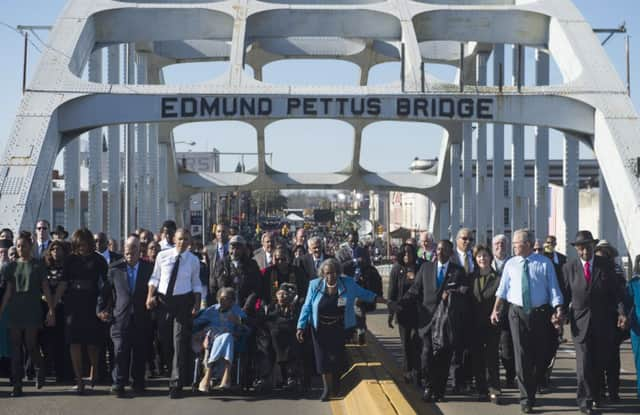Barack Obama walks across bridge at Selma


Tens of thousands joined him to commemorate the “Bloody Sunday” march of 1965 and take stock of the struggle for equality.
Under a bright sun, the first black US president praised the figures of a civil rights era that he was too young to know but that helped him break the ultimate racial barrier in political history with his ascension to the nation’s highest office. He called them “warriors of justice” who pushed the United States closer to a more perfect union.
Advertisement
Hide AdAdvertisement
Hide Ad“So much of our turbulent history – the stain of slavery and anguish of civil war, the yoke of segregation and tyranny of Jim Crow, the death of four little girls in Birmingham, and the dream of a Baptist preacher – met on this bridge,” Mr Obama told the crowd before taking a symbolic walk across part of the Edmund Pettus Bridge, where the 1965 marchers were attacked by police.
“It was not a clash of armies, but a clash of wills, a contest to determine the meaning of America,” Mr Obama said. He was three years old at the time.
A veteran of that clash, John Lewis, who was severely beaten by police that day in 1965 and suffered a skull fracture, exhorted the crowd to press on with the work of racial justice.
“Get out there and push and pull until we redeem the soul of America,” Mr Lewis said. He was the youngest and is the last survivor of the Big Six civil rights activists, a group led by Martin Luther King that had the greatest impact on the movement.
Selma’s fire department estimated the crowd at 40,000. Former president George W Bush shared the platform. Republican congressional leaders were mostly absent but one, House Majority Leader Kevin McCarthy, joined the walk.
It progressed under the bold letters on an arch, identifying the bridge named after Pettus, a Confederate general in the American Civil War, senator and reputed Ku Klux Klan leader.
Mr Obama, his wife, Michelle, and their two daughters walked about a third of the way across, accompanied by Mr Lewis. Mr Bush, his wife, Laura, and scores of others came with them before a larger crowd followed.
Two years after King’s historic “I have a dream” speech in Washington, the Bloody Sunday march became the first of three aiming to reach Montgomery, Alabama, the state capital, to demand an end to discrimination against black voters.
Advertisement
Hide AdAdvertisement
Hide AdScenes of troopers beating marchers on the bridge shocked the nation, emboldening leaders in Washington to pass the Voting Rights Act five months later.
On his way to Selma, Mr Obama signed a law awarding the Congressional Gold Medal to participants in the trio of marches.